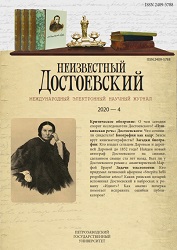Семантика и идеография рукописного текста Достоевского: от почерка к смыслу
Semantics and Ideography of Dostoevsky’s Handwritten Text: from Handwriting to Meaning
Author(s): Natalia Aleksandrovna Tarasova, Tatyana Viktorovna PanyukovaSubject(s): Semantics, Russian Literature, 19th Century, Theory of Literature
Published by: Петрозаводский государственный университет
Keywords: Fedor Dostoevsky; workbooks; manuscripts drafts; textual criticism; handwriting; calligraphy;
Summary/Abstract: The paper analyzes the material from two workbooks (1864–1867) that belonged to Fedor Dostoevsky (Russian State Archive of Literature and Art. Collection 212, inventory 1, storage units 4 and 5). The research was conducted in three main areas: selection of information for the letter style alphabet; comparative analysis of sources (manuscripts and publications of handwritten text) for the purpose of identifying and correcting errors in its reading; a review of calligraphy and graphics of Fedor Dostoevsky. The alphabet of letter styles allows to establish typical and atypical letter styles in the handwriting of Fedor Dostoevsky. This made it possible to compile a classification of letters, describe their features, and use this information in the study of difficult-to-read and previously undecipherable records. The latter may contain valuable information that allows to clarify the facts in the creative history of the works of Fedor Dostoevsky, biographical information, chronology of the creative process, and so on. The second area of research includes the comparative analysis of manuscript sources and their published versions — is of particular value for ascertaining the original author’s text and eliminating the inaccuracies of research interpretations that often appear in the process of manuscript publishing. There is a direct connection between these areas of analysis — the letter style alphabet is a tool that allows to read the handwritten text more accurately and correct the mistakes of the publishers. The third direction, dedicated to the study of calligraphy, expands the range of tasks related to the study of graphics in the writer’s texts and allows to draw preliminary conclusions about the nature of its function in the handwritten text. The scientific novelty of the work consists in the systematization of data on the writer’s handwriting in manuscripts of the specified period, on the features of his creative work, and in correcting the errors made by publishers of handwritten materials and restoring the true meaning of the author’s notes. The practical value of the work consists in collecting information about the writer’s handwriting, which is relevant for the textual analysis of his works, publication of his texts, and use of the collected information for subsequent scientific work.
Journal: Неизвестный Достоевский
- Issue Year: 7/2020
- Issue No: 4
- Page Range: 222-292
- Page Count: 71
- Language: Russian

